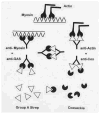Unresolved issues in theories of autoimmune disease using myocarditis as a framework
- PMID: 25484004
- PMCID: PMC4417457
- DOI: 10.1016/j.jtbi.2014.11.022
Unresolved issues in theories of autoimmune disease using myocarditis as a framework
Abstract
Many theories of autoimmune disease have been proposed since the discovery that the immune system can attack the body. These theories include the hidden or cryptic antigen theory, modified antigen theory, T cell bypass, T cell-B cell mismatch, epitope spread or drift, the bystander effect, molecular mimicry, anti-idiotype theory, antigenic complementarity, and dual-affinity T cell receptors. We critically review these theories and relevant mathematical models as they apply to autoimmune myocarditis. All theories share the common assumption that autoimmune diseases are triggered by environmental factors such as infections or chemical exposure. Most, but not all, theories and mathematical models are unifactorial assuming single-agent causation of disease. Experimental and clinical evidence and mathematical models exist to support some aspects of most theories, but evidence/models that support one theory almost invariably supports other theories as well. More importantly, every theory (and every model) lacks the ability to account for some key autoimmune disease phenomena such as the fundamental roles of innate immunity, sex differences in disease susceptibility, the necessity for adjuvants in experimental animal models, and the often paradoxical effect of exposure timing and dose on disease induction. We argue that a more comprehensive and integrated theory of autoimmunity associated with new mathematical models is needed and suggest specific experimental and clinical tests for each major theory that might help to clarify how they relate to clinical disease and reveal how theories are related.
Keywords: Antigenic complementarity; Autoimmune disease theories and modeling; Infection; Myocarditis; Sex differences.
Copyright © 2014 Elsevier Ltd. All rights reserved.
Figures












Similar articles
-
Autoimmunity in viral myocarditis.Curr Opin Rheumatol. 2013 Jul;25(4):502-8. doi: 10.1097/BOR.0b013e3283620036. Curr Opin Rheumatol. 2013. PMID: 23656709 Review.
-
Evidence for mimicry by viral antigens in animal models of autoimmune disease including myocarditis.Cell Mol Life Sci. 2000 Apr;57(4):552-60. doi: 10.1007/PL00000717. Cell Mol Life Sci. 2000. PMID: 11130455 Free PMC article. Review.
-
Antigenic complementarity between coxsackie virus and streptococcus in the induction of rheumatic heart disease and autoimmune myocarditis.Autoimmunity. 2009 Jan;42(1):1-16. doi: 10.1080/08916930802208540. Autoimmunity. 2009. PMID: 18608177 Review.
-
Autoimmunity in coxsackievirus B3 induced myocarditis.Autoimmunity. 2006 Feb;39(1):55-61. doi: 10.1080/08916930500484906. Autoimmunity. 2006. PMID: 16455582 Review.
-
From infection to autoimmunity.J Autoimmun. 2001 May;16(3):175-86. doi: 10.1006/jaut.2000.0492. J Autoimmun. 2001. PMID: 11334481 Review.
Cited by
-
Inhibition of microRNA-155 ameliorates experimental autoimmune myocarditis by modulating Th17/Treg immune response.J Mol Med (Berl). 2016 Sep;94(9):1063-79. doi: 10.1007/s00109-016-1414-3. Epub 2016 Apr 6. J Mol Med (Berl). 2016. PMID: 27052830
-
Cardiovascular consequences of viral infections: from COVID to other viral diseases.Cardiovasc Res. 2021 Nov 22;117(13):2610-2623. doi: 10.1093/cvr/cvab315. Cardiovasc Res. 2021. PMID: 34609508 Free PMC article. Review.
-
Autoimmunity and the microbiome: T-cell receptor mimicry of "self" and microbial antigens mediates self tolerance in holobionts: The concepts of "holoimmunity" (TcR-mediated tolerance for the holobiont) and "holoautoimmunity" (loss of tolerance for the holobiont) are introduced.Bioessays. 2016 Nov;38(11):1068-1083. doi: 10.1002/bies.201600083. Epub 2016 Sep 5. Bioessays. 2016. PMID: 27594308 Free PMC article.
-
An E321G MYH1 mutation is strongly associated with nonexertional rhabdomyolysis in Quarter Horses.J Vet Intern Med. 2018 Sep;32(5):1718-1725. doi: 10.1111/jvim.15299. Epub 2018 Aug 5. J Vet Intern Med. 2018. PMID: 30079499 Free PMC article.
-
A Pharmacoepidemiological Study of Myocarditis and Pericarditis Following the First Dose of mRNA COVID-19 Vaccine in Europe.Microorganisms. 2023 Apr 22;11(5):1099. doi: 10.3390/microorganisms11051099. Microorganisms. 2023. PMID: 37317073 Free PMC article.
References
Publication types
MeSH terms
Substances
Grants and funding
LinkOut - more resources
Full Text Sources
Other Literature Sources
Medical

